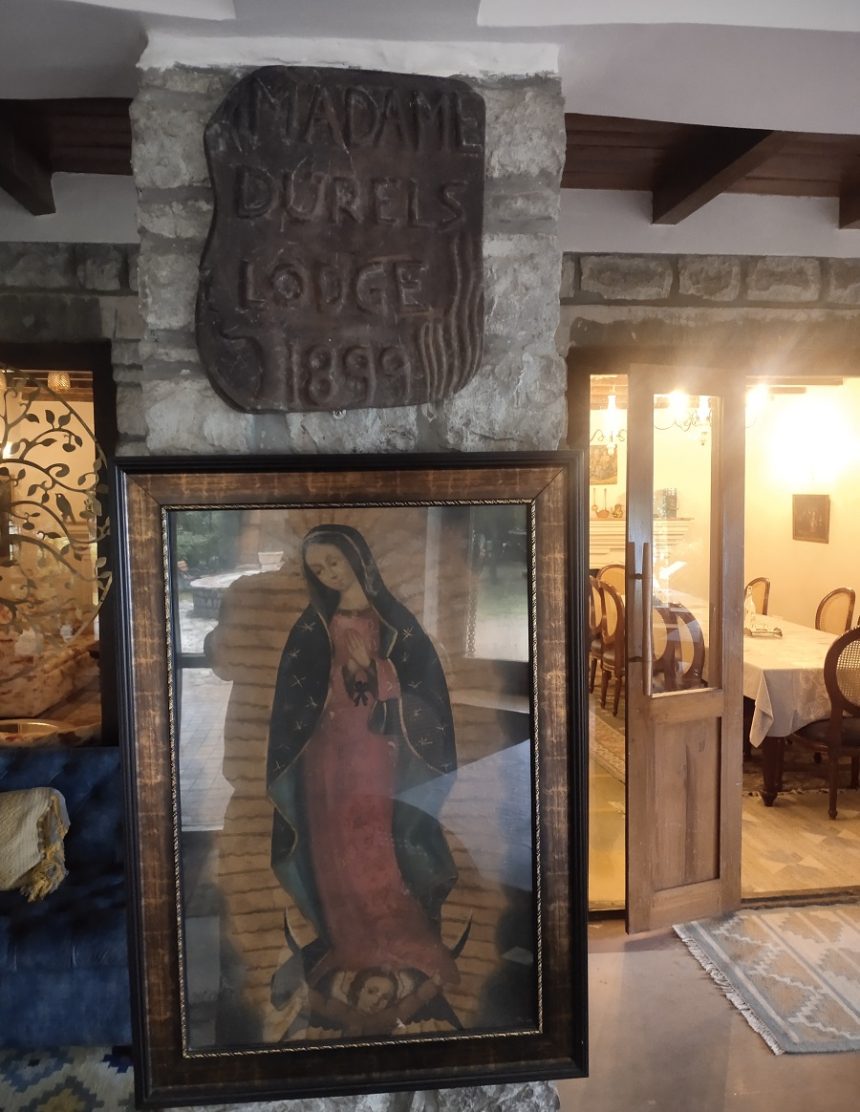‘Blue Book Ghetiya’: A Byname for ‘Heritage Tourism’ In Uttrakhand
All in all this ‘World Tourism Day’ Blue book Ghetiya would be a perfect get away from the maddening crowd to partake in the real joys of life

By Colonel Satish Singh Lalotra
Like all great travellers, I have seen more than I remember and remember more than I have seen. A good traveller has no fixed plans and is not intent on arriving. But then there are some out of the blue places on this planet of ours which willy nilly brand their presence in our psyche so as to make a traveller intent on arriving at that place to savour in its uniqueness of tourism potential that may be missing in most of its ilk. ‘Blue book Ghetiya’ near Nainital is one such extra ordinary location that has the potential of putting a visitor in a state of trance by the sheer force of its past historicity, location, climatic condition enveloping the place and the warmth exuding from its hospitality staff all rolled into one heady cocktail; that refuses to leave its hangover long after you have said goodbye to the place.
Though the state of Uttrakhand has always been identified with some of the most exquisite locales in India which bewitch a traveller to no end , yet all are not backed by a rich past that could hold the attention of tourists with an unequivocal aplomb transcending myriad time zones /spaces as has been the wont of ‘Blue Book Ghetiya’. But why the prefix of words ‘Blue Book’ for this location that is just a stone’s throw away from Nainital? Any guesses? Well, in the yesteryears of the western globe there used to be ritual of having socially eminent dignitaries mentioned in a list. The collective was called as the ‘Blue Book’. Since then, the world has progressed to include more perspectives as well as personalities. Discoveries have replaced stories; explorations have restored tales. Hence the new kind of travels. They reach for the depths of the earth and fly to the highs of the blue. They wander the widths of the wild and script a life of their choice.
It goes to the ingenuity and out of the box thinking of the proprietor of this heritage complex to bestow the name ‘Blue Book’ as if sensing the mood of the tourism market where a visitor or a tourist reigns supreme and chugs the wheels of his business by becoming a routine visitor to this unique place. The name ‘Blue Book’ metaphors every visitor to this heritage cum boutique hotel as a ‘Socially eminent personality’ as mentioned by me above. Could it be a business ploy to attract more visitors to this place? Yes, most probably it is. But then a visit to this unique location reinforces the concept encapsulating that ‘Blue Book Ghetiya’ stands for. It was last September that I had taken some time out with family to visit this ‘boutique cum heritage cottage’ which is just about few kilometers short of Nainital –the queen of Kumaon hills.
The month of September incidentally every year since 1980 has been heralding ‘World Tourism Day’ that marks the anniversary of the adoption of the statutes of the organization in 1970, paving the way for the establishment of UN Tourism five years later. The timing of ‘World tourism day’ is particularly appropriate in that it comes at the end of the high season in the northern hemisphere and the beginning of the season in the southern hemisphere. Every year since the ideation of this noble step to bring tourism to the door steps of the world community, the day has often been tagged with some famous ‘Tag-line’ that encapsulates the essence of that time in totality. This year the World tourism day has been tagged with the theme line –‘Tourism and peace’. What an apt correlation between the two, since neither can survive without each other. There can’t be any tourism without an abiding peace and for having peace people to people movement and interactions are a must which are the two main components of tourism.
Coming back to my main theme of this write up that centers around ‘Blue Book Ghetiya’ near Nainital, I chanced upon to hit this place on sifting through a mine of information on world famous hunter cum conservator Jim Corbett who used to be a regular visitor to this cottage on way to Nainital that was owned by one Madame ‘Durrell’ of England. A fast friend of the world famous hunter, Madame Durrell had built this cottage in the year 1899 and termed it as Madame Durrell’s lodge catering primarily to the imperial British army officers, their families, civilian dignitaries including the then commissioner of Kumaon region who were on their way up to Nainital for official or otherwise visits to cool off the tropical heat of India.
With barely 9 kilometers separating Ghetiya from Nainital covered in less than 30 minutes, this heritage cum boutique cottage is the perfect precursor before one sets his or her foot on the ever busy mall road of Nainital. Rather off late majority of tourists prefer to camp at such places making it as their base to wheel in and out of Ghetiya, sightseeing at Nainital and fall back after a day’s excursion. It’s both convenient on time and health of a visitor but slightly heavier on the pocket for choosing such an offbeat location which an avid traveller doesn’t mind to loosen his purse strings for. As if this was not enough for ‘Blue Book Ghetiya’ to hog the lime light in the tourist circles, it also has the USP of being categorized as a ‘Boutique hotel’, a moniker which seldom is the preserve of best of hotels in the state of Uttrakhand.
To the readers of this write-up ‘Boutique hotel’ might sound slightly ‘outlandish’ in its terminology, but then the rich historicity of this heritage cottage just about qualifies it for this moniker. Even as per INTACH (Indian national trust for art and cultural heritage) any building or structure that is standing perfect even after 100 years/ century comes under the ambit of a heritage building. With more than 125 long years under its solid foundation, ‘Blue book Gheitya’ doesn’t have to look askance to make it to the unique club of ‘Heritage cum boutique buildings’. The tag of belonging to a ‘Boutique hotel cum cottage’ comes naturally to ‘Blue Book Ghetiya’ since it was built during the British colonial era by Madame Durrell in 1899 when the imperial British Raj was at its zenith. According to oxford English dictionary, a boutique hotel is a small stylish hotel typically located in a fashionable urban location. It has a distinct character, intentional design and décor backed up by a personalized service. Though the idea seems timeless, the term ‘boutique hotel’ hasn’t been around very long.
After opening the Morgans hotel in New York City in 1984, legendary hotelier Ian Schrager and his business partner Steve Rubell coined the term. The unique characteristics that go with this type of Boutique hotel are its small size with typically fewer than 100 rooms, small restaurants or bars, few recreational facilities and limited meeting place. Each boutique hotel has a unique theme, some are historic, some are culinary –focused, and some focus on specific elements like a book, a colour or a famous figure. The theme is present not only in the hotel’s aesthetic, but perhaps also in its name, staff uniforms, amenities and more.
‘Blue Book Ghetiya’ near Nainital meets all the above USPs as delineated by me above squarely on its face. The location of this unique setup decided by Madame Durrell more than a century plus is its biggest USP. Nestled in a very lush green spot away from constructions, you can see Nainital on one side glistening on a whole mountain side with far ranging mountains making its other backdrop. The architecture of this heritage cum boutique hotel is timeless with each room called as chapter (of a book) permeating a different style, space& view of the splendid Jeolikote valley down below. Jeolikote incidentally was patronized by the British as a recuperating center for its troops and general populace that had left the shores of England to make India as their second home, since the weather very closely resembled that of the UK for a major part of the year.
Once inside the complex there are multiple outdoor spaces and niches for different groups to play, eat and enjoy. Also, everything is like a time machine –the rotary phones in the rooms with one room still having a working phone of late 19th century vintage connected to the Nainital telephone exchange. This telephone has the distinction of being the oldest in the entire Kumaon region dating to the British times and still ringing to glory. The roof of this entire heritage complex is surprisingly supported by the timeless beams of Cedar (Devdar) trees that were cut by the lumber people of Kumaon, and brought on elephant backs to the location. The amazing part of these Cedar beams is that unlike the present Cedar beams which are drained off their cedar oil by the forest department thus making them weak in its grain composition; the Cedar beams used in Blue book still retain the cedar oil in them thus making them as strong as iron beams with an astonishing ‘Load bearing’ capacity. Not a single beam of cedar has been changed since 1899 in this entire complex which goes to prove the strength of this building which to my estimate could stand another decade or two without any major overhaul.
Blue book still houses the remains of the pet dog of Madame Durrell with a suitable epitaph dedicated to the memory of the animal. It has an ethereal charm combined with a tinge of luxury. A well-Stocked library with a range of books suiting the reading palette of all and sundry visiting the hotel takes a visitor by surprise. A rarity in such times and places to find. Every piece in each room has been hand-picked, with every comfort thought of by the staff and the management. I had the luck of being hosted to at this place with the staff and management going the extra mile in making arrangements for drinks and dinner under the star-lit night of Nainital with a big TV screen cum projector installed for screening choicest of songs and movies in the front lawns of Blue book with the cottage itself forming a perfect backdrop for the evening.
The ultimate which a visitor is exposed to is the curated experience organized by the Blue Book. You can have each meal at different spots throughout the property with each more breathtaking than the earlier, which otherwise is an anathema for such star rated hotels cum cottages. This property was sold-out by Madame Durrell when she decided to migrate to England to her few acquaintances who in turn retained it for few decades and later on disposed off to their Indian servants. It was lying in a state of dereliction for quite a few years when Tarun Tejpal of Tehlka dot com bought it and turned it on for its betterment. After some time the same was bought in by Shrey Gupta a curious traveller, an adventure seeker, and now a hotelier. Punita Raju & Natraju belonging to the international hospitality chain brought back this property to life by their design and execution. Shobha Rudra, the famous marketing and communications professional of ‘Rare India’ a hospitality marketing platform has put in her expertise to jack up this place in the tourist circles of the world.
All in all this ‘World tourism day’ Blue book Ghetiya would be a perfect get away from the maddening crowd to partake in the real joys of life.
(The writer is a regular scribe of RK & can be approached on his email—slalotra4729@gmail.com)




